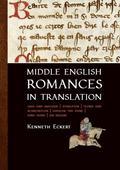The popular romances of medieval England are fantasy stories of love at first sight; brave knights seeking adventure; evil stewards; passionate, lusty women; hand-to-hand combat; angry dragons; and miracles. They are not only fun but indicate a great deal about the ideals and values of the society they were written in. Yet the genre of Middle English romance has only recently begun to attain critical respectability, dismissed as "vayn carpynge" in its own age and generally treated by twentieth-century critics as a junk-food form of medieval literature. Chaucer's Tale of Sir Thopas has been assumed to be a satire of the romances' clichéd formulas and unskilled authors. But the romances evidently enjoyed popularity among all English classes, and the genre itself continued to flourish and evolve down to present-day novels and movies. Whatever Chaucer and his contemporaries thought of romances, they would have needed some personal familiarity with the stories and texts for comic tales such as Sir Thopas to be understood. A century ago, Beowulf faced the same problem that the Middle English romances still face: no modern translations were published because few had heard of the poem- because there were no modern translations published. Where the romances have been printed, they have normally been reproduced as critical editions in their original language, or translated into heavily abridged children's versions, but few have been published as scholarly close line translations with notes. This book is an attempt to remedy this by making some of these romances available to the student or lay reader who lacks specialized knowledge of Middle English, with the hope that a clearer understanding of the poems will encourage not only enjoyment but also further study.


